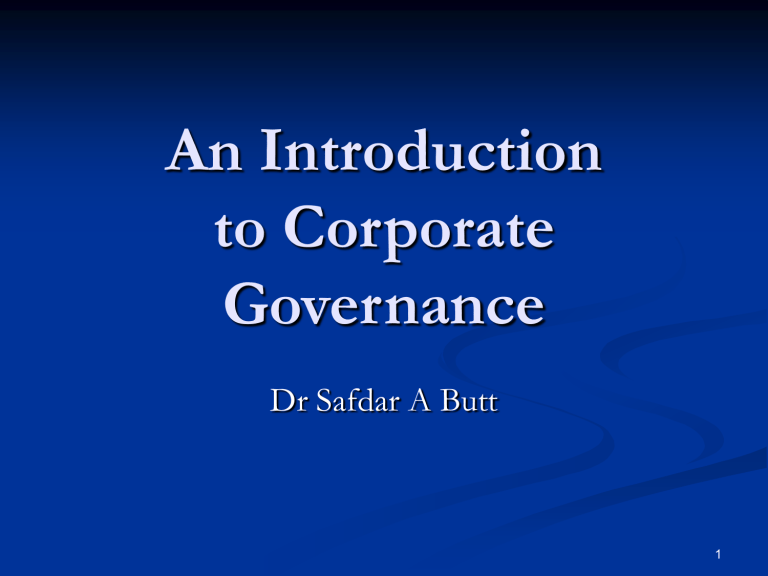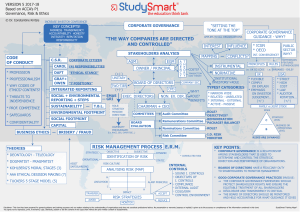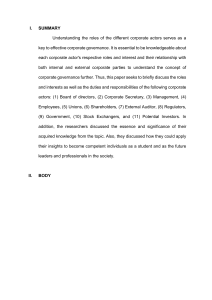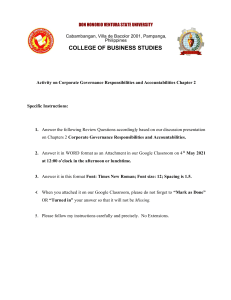
An Introduction to Corporate Governance Dr Safdar A Butt 1 What is it about? Corporate Governance 2 Company What is a company? Characteristics of a Company Types of Companies 3 Characteristics of a Company Ownership in shares Freely transferable shares Separate entity apart from shareholders Liability of shareholders Indefinite life Separation of ownership from management: Board of directors 4 Types of Companies Limited or Unlimited Limited by shares or by guarantee Private or Public Listed or Unlisted 5 Hierarchy of a Company Shareholders Board of Directors Own the company, do not run it. Elected by and reporting to shareholders Management Appointed by and reporting to directors Includes executive directors 6 Top Players Shareholders: Voting power Chairman: Directors May be executive or non-executive Chief Executive Officer May be executive or non-executive May or may not be a director Senior Managers: May or may not be directors 7 Classification of Stakeholders Owners Lenders Employees Business Associates Suppliers and Customers Society Includes government 8 Opportunity to protect individual interests Managers and Employees have the greatest opportunity to protect their interest(s) Suppliers and Clients essentially go by each transaction or contract. Lenders and Shareholders are most vulnerable. Society depends entirely on law 9 Classification of Stakeholders Classified on basis of Role in the Company Classified on basis of opportunity to protect individual interests Those with Full Opportunity Those with a Partial Opportunity Those with Virtually No opportunity Owners Controlling Shareholders Institutional Investors with Board representation Minority and individual shareholders with no board Representation Lenders Financial institutions with elaborate lending Contracts Buyers of listed bonds with trustee arrangements Other lenders Employees Executive Directors Senior Managers Other employees on regular or contract terms Business Associates Suppliers who sell only on cash terms Major Suppliers and clients with contracts Smaller suppliers and smaller clients Government Public at large Society 10 Individual Vs Collective Interest Interests of various stakeholders differ Shareholders: Share Value & Profit Management: Survival & Job Security Lenders: Debt security, low risk Society: Environmental/Economic Issues How to create a balance? 6 February 2022 Corporate Governance - Dr S A Butt 11 Need for a System There is a need for a system to ensure that: Individual interest of each stakeholder is protected and served. Collective interest of all stakeholders is protected and served. No one usurps any one else’s rights. No one has monopoly of making decisions. Corporate Governance is that system. 6 February 2022 Corporate Governance - Dr S A Butt 12 Definition Corporate governance refers to the mechanism used to control and direct the affairs of a corporate body in order to serve and protect the individual and collective interests of all its stakeholders. 6 February 2022 Corporate Governance - Dr S A Butt 13 Governance & Management How do these terms differ? Does Governance include Management? Or Does Management include Governance? 14 Governance & Management Governance Function Management Approval of Plans Planning Preparation of plans Providing overall leadership Leading Leading those who implement plans Arranging resources Organizing Tasks division & resource usage Controlling managers Controlling Controlling employees 15 Governance Strategic Setting Objectives Devising plans to achieve these objectives Setting rules or parameters Not directly concerned with routine affairs Protection of Interests of all stakeholders 16 Management Current & Operational Affairs Taking directions from the Board Implementing the Plans Developing Suggestions and Alternatives 17 Approaches to Corporate Governance Shareholders Approach Stakeholders/Plurist Approach Enlightened Shareholders Approach Which approach is best? 18 Corporate Sins Sloth Greed Unwillingness to take initiative or risk, prefer status quo, be lazy. Putting self above company Fear Not annoy or stand up to any stakeholder / investor / boss. 19 Agency Theory What is Agency Theory? Does it apply to companies? Two-party and three-party model Principal-Watchdog-Agent 20 Key Issues in CG Financial reporting Directors’ remuneration Risk management Effective communication Corporate Social Responsibility 21 Financial Reporting Accuracy Reliability Internal and external audit Comprehensiveness Timeliness 22 Directors Related Issues Remuneration Powers and functions Balance between: executive and non-executives Election and re-election Representation 23 Risk Management Risk profile What risks to take? Avoidable and non-avoidable risks What not to take? How to handle risks taken? 24 Communication Transparency Regular communication With who? In what format? 25 Corporate Social Responsibility Business Ethics Being a good citizen Doing business responsibly 26 Why is CG Important? Good reputation is good business Protection of stakeholders’ interest Support to capital markets Support to society Every one wins 27 Thank you Dr S A Butt 28








